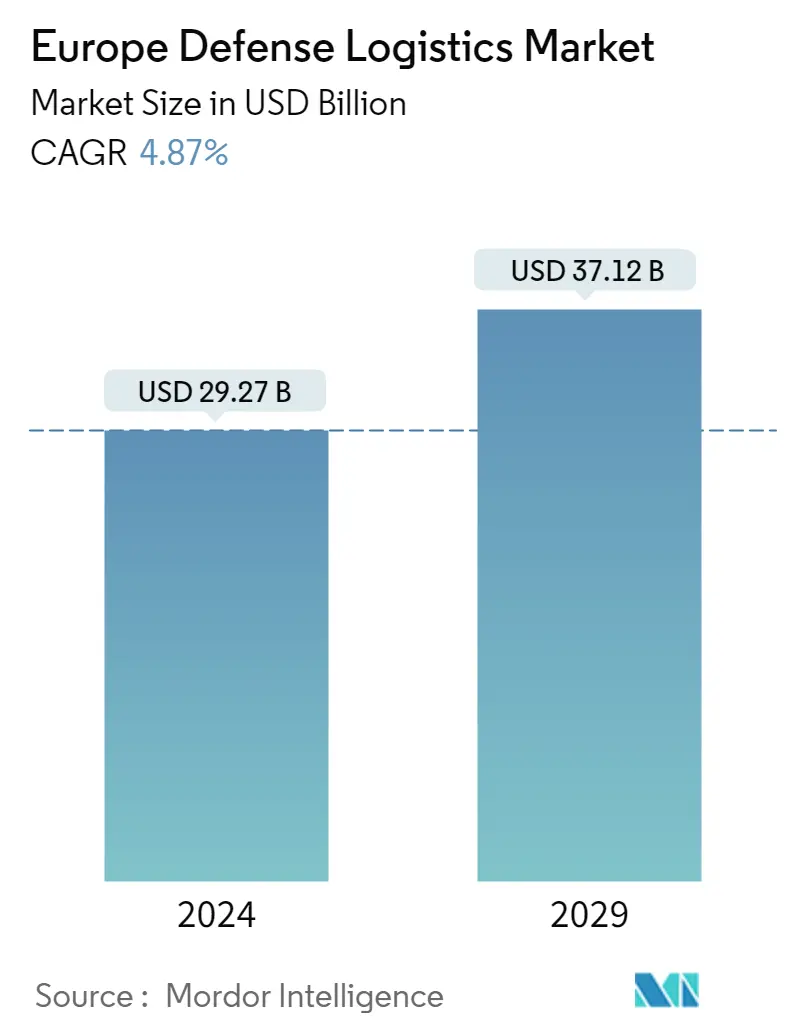Market Size of Europe Defense Logistics Industry

| Study Period | 2019 - 2029 |
| Base Year For Estimation | 2023 |
| Forecast Data Period | 2024 - 2029 |
| Market Size (2024) | USD 29.27 Billion |
| Market Size (2029) | USD 37.12 Billion |
| CAGR (2024 - 2029) | 4.87 % |
| Market Concentration | Low |
Major Players
*Disclaimer: Major Players sorted in no particular order |
Europe Defense Logistics Market Analysis
The Europe Defense Logistics Market size is estimated at USD 29.27 billion in 2024, and is expected to reach USD 37.12 billion by 2029, growing at a CAGR of 4.87% during the forecast period (2024-2029).
- Since national security comes first, practically, they continued with all military procurement, maintenance, and logistics even while the world battled the COVID-19 outbreak. Additionally, the nationwide lockdown and supply chain irregularities are causing the logistics provider to experience a cash crisis.
- Businesses located in or dependent on supply chain operations from countries that were severely affected by the epidemic were the first victims of the disease. Technology companies put a greater emphasis on high-demand inventions and developed innovative methods of supporting their customers. However, the use of cooperative strategies by various military and logistic service providers to address supply chain-related problems helped to resolve the issue.
- In order to address the deteriorating security environment following Russia's aggression against Ukraine and to strengthen the EU's ability to protect its citizens and infrastructure, the Commission and the High Representative presented an Action Plan on Military Mobility 2.0 and a Joint Communication on an EU cyber defense policy.
- The Action Plan on Military Mobility will allow European military forces, in particular, to respond to crises that break out at the EU's external borders and elsewhere better, faster, and at a sufficient scale. It will improve the EU's capacity to assist Member States and allies with the transportation of troops and their supplies. It streamlines regulatory concerns while aiming for more connected and secure infrastructure. It will advance connection and communication with important partners and strengthen collaboration with NATO.
Europe Defense Logistics Industry Segmentation
Europe Defense logistics Market are essential elements for the functioning of the armed forces as they facilitate the timely delivery and supply of essential materials such as ration, equipment, arms, and ammunition to the military bases for sustained operation. The various Defense Logistics service providers are considered under the purview of the report to depict a holistic overview. The report also takes into account the various research and development (R&D) initiatives undertaken by the defense forces and associated supply chain players. It is to enhance the degree of responsiveness and visibility of in-transit items in the military logistics sector.
Europe Defense Logistics Market is segmented by service type (armament, military troops, technical support maintenance, medical aid, fire fighting protection, and others), transportation mode (roadways, airways, seaways, and railways), and end-user (army, navy, air force, and others). The report offers Europe Defense Logistics Market size and forecasts in values (USD) for all the above segments.
| By Service Type | |
| Armament | |
| Military troops | |
| Technical support maintenance | |
| Medical aid | |
| Fire fighting protection | |
| Others |
| By Transportation mode | |
| Roadways | |
| Airways | |
| Seaways | |
| Railways |
| By End User | |
| Army | |
| Navy | |
| Air force | |
| Others |
Europe Defense Logistics Market Size Summary
The Europe Defense Logistics Market is poised for significant growth over the forecast period, driven by the increasing emphasis on national security and military preparedness. Despite challenges such as the COVID-19 pandemic, which disrupted supply chains and caused financial strain on logistics providers, the sector has shown resilience. The geopolitical landscape, particularly following Russia's aggression against Ukraine, has prompted the European Union to enhance its military mobility and cyber defense capabilities. Initiatives like the Action Plan on Military Mobility 2.0 aim to improve the EU's response to external crises and strengthen infrastructure connectivity. The integration of advanced technologies such as artificial intelligence, robotics, and the Internet of Things is transforming defense logistics, enabling more efficient operations and improved situational awareness.
The market is characterized by a fragmented landscape, with a strong preference for domestic procurement among EU member states, which poses challenges to collaboration and interoperability. Despite these hurdles, strategic acquisitions and investments are shaping the market dynamics. Companies like Scan Global Logistics and INTRACOM DEFENCE are expanding their footprints and capabilities through strategic acquisitions, enhancing their roles in the defense logistics sector. The focus on enhancing infrastructure, such as multimodal terminals and railway expansions, is supported by significant funding from the European Commission. These developments underscore the ongoing efforts to achieve strategic autonomy and improve the efficiency of defense investments across Europe.
Europe Defense Logistics Market Market Size - Table of Contents
-
1. MARKET DYNAMICS
-
1.1 Market Overview
-
1.2 Market Drivers
-
1.2.1 Humanitarian and disaster relief operations driving the market
-
1.2.2 Efforts of Mordernization enhancing the market
-
-
1.3 Market Restraints
-
1.3.1 Changes in the government policies might affect the market
-
1.3.2 Insufficient transportation networks affecting the market
-
-
1.4 Market Oppurtunities
-
1.4.1 Cybersecurity and data protection enhancing the market
-
1.4.2 Collaboration and interoperability enhancing the market
-
-
1.5 Industry Attractiveness - Porter's Five Forces Analysis
-
1.5.1 Bargaining Power of Suppliers
-
1.5.2 Bargaining Power of Buyers/Consumers
-
1.5.3 Threat of New Entrants
-
1.5.4 Threat of Substitute Products
-
1.5.5 Intensity of Competitive Rivalry
-
-
1.6 Impact of COVID-19 on the Market
-
-
2. MARKET SEGMENTATION
-
2.1 By Service Type
-
2.1.1 Armament
-
2.1.2 Military troops
-
2.1.3 Technical support maintenance
-
2.1.4 Medical aid
-
2.1.5 Fire fighting protection
-
2.1.6 Others
-
-
2.2 By Transportation mode
-
2.2.1 Roadways
-
2.2.2 Airways
-
2.2.3 Seaways
-
2.2.4 Railways
-
-
2.3 By End User
-
2.3.1 Army
-
2.3.2 Navy
-
2.3.3 Air force
-
2.3.4 Others
-
-
Europe Defense Logistics Market Market Size FAQs
How big is the Europe Defense Logistics Market?
The Europe Defense Logistics Market size is expected to reach USD 30.70 billion in 2025 and grow at a CAGR of 4.87% to reach USD 38.93 billion by 2030.
What is the current Europe Defense Logistics Market size?
In 2025, the Europe Defense Logistics Market size is expected to reach USD 30.70 billion.

